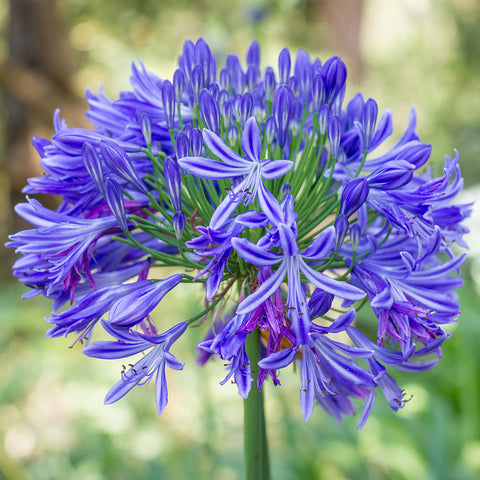Agapanthus Varieties: Choosing the most effective for Your Landscape
Agapanthus Varieties: Choosing the most effective for Your Landscape
Blog Article
Grasping the Art of Agapanthus Treatment: Crucial Actions for Healthy And Balanced Development and Lively Blossoms
In the world of cultivation, the cultivation of agapanthus stands as a gratifying venture for those who seek to nurture these elegant blooming plants. From picking the ideal variety to understanding trimming methods, the trip towards growing prospering agapanthus plants is diverse and holds the vital to unlocking the full potential of these agricultural treasures.

Selecting the Right Agapanthus Range

When picking the appropriate Agapanthus range for your garden, take into consideration variables such as climate suitability, bloom shade, and growth habit. Additionally, take into consideration the environment in your region to ensure the Agapanthus variety you choose can prosper in your details problems. Recognizing the development practice of different Agapanthus selections is vital for correct placement within your garden.
Suitable Planting Problems
Thinking about the optimal environmental needs is essential for successful Agapanthus growing. Agapanthus prospers in well-draining dirt with a slightly acidic to neutral pH level. When growing, pick a location that obtains full sunlight to partial shade. In hotter environments, offering some afternoon color can stop scorching of the fallen leaves. Agapanthus plants are sensitive to cool temperatures and should be secured from frost throughout cold weather.
To guarantee healthy and balanced growth and vibrant flowers, plant Agapanthus bulbs at a deepness of about 2-4 inches and space them 8-12 inches apart. Adding raw material, such as garden compost, to the dirt can boost drain and fertility, advertising robust root advancement. Mulching around the base of the plants assists keep moisture and suppresses weed development. Regular watering is vital, specifically during the expanding period, to keep the dirt consistently damp yet not soaked.
Watering and Fertilizing Tips
Keeping correct wetness levels and supplying vital nutrients are essential components in the treatment regimen for Agapanthus plants. When it comes to watering Agapanthus, it is critical to strike a balance. These plants prefer regularly moist dirt but are susceptible to root rot if overwatered.
Feeding Agapanthus is necessary for advertising healthy and balanced development and prolific blooms. Apply a well balanced fertilizer, such as a 10-10-10 formula, in the early spring as brand-new growth emerges. By following these watering and fertilizing tips, you can ensure your Agapanthus plants flourish and produce lively, resilient blooms.
Pruning Strategies for Agapanthus
Pruning Agapanthus plants at the proper times and with correct methods is crucial for keeping their health and wellness and advertising optimal growth and blooming. The ideal time to trim Agapanthus is in late winter season or early springtime before new growth emerges. Start by this content eliminating any yellowing or dead leaves near the base of the plant. Cut them as close to the ground as feasible without damaging the emerging shoots.
Deadheading invested blossoms can additionally redirect the plant's power right into producing even more flowers rather than establishing seeds. If you desire to accumulate seeds for propagation, leave pop over to this site some flowers to fully grown and dry on the plant.
Remember to make use of tidy, sharp tools to make precise cuts and lower the threat of introducing diseases. Agapanthus. Regular trimming will certainly help keep your Agapanthus looking healthy and balanced and neat while ensuring an abundant display screen of beautiful blossoms
Managing Common Insects and Illness
After ensuring proper pruning techniques for Agapanthus, it is vital to resolve typical pests and conditions that can affect the health and vitality of these plants. One common pest that affects Agapanthus is the Agapanthus gall midge.
In addition, Agapanthus plants can experience from origin rot if they are grown in inadequately draining pipes soil. By being alert and taking prompt activity against conditions and bugs, you can help your Agapanthus plants grow and produce lively blooms. Agapanthus.

Verdict
In final thought, grasping the art of agapanthus treatment involves choosing the best range, supplying optimal planting conditions, correct watering and fertilizing, ideal trimming strategies, and resolving typical pests and illness. By complying with these crucial actions, you can make sure healthy and balanced growth and vibrant blooms for your agapanthus plants. Remember to frequently monitor and keep your plants to promote their general health and longevity.
To make sure healthy and balanced development and vivid blossoms, plant Agapanthus light bulbs at a depth of regarding 2-4 inches and space them 8-12 inches apart. By adhering to these watering and fertilizing pointers, you can guarantee your Agapanthus plants grow and create dynamic, durable blooms.
One common bug that affects Agapanthus is the Agapanthus gall midge. Furthermore, Agapanthus plants can suffer from root rot if they are grown you could look here in improperly draining pipes dirt. By adhering to these essential steps, you can guarantee healthy growth and dynamic blooms for your agapanthus plants.
Report this page